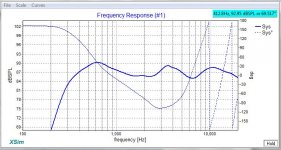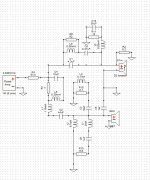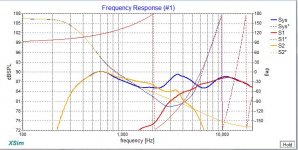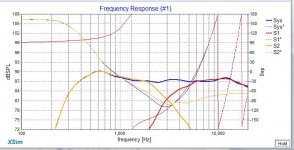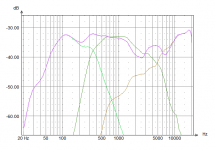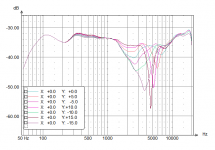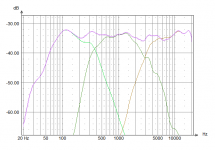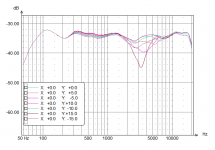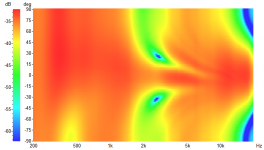B&W 800is a excellent design and miles away the reach most diyersSure ,and Hummer is a great car to commute to work, and pumped up 50 year old Hollywood doll an object of virtual desire 😉
I can't afford any of those so I'm biting my nails out of jealousy and enrage aspiring masses...
Wake up , it's the DIY place , not a church to worship an aspirational semi-mass produced, nuvo riche MDF sculpture..
cheers,
Let me guess ...You just became an elected official and need a "prestige"
of well recognized brand necessary in such circumstances ? 😀
The alternative would be a spouse's pressure , Usually their need of prestige is far greater .....😉
Anyway , without all that leather and walnut Serblin would not generate nearly as much of excitement based on the sound alone.
Here you can find my Ekta's... Troelsova Ekta Grande - Project gallery/WIKI - diyAudio.rs
I borowed them to my friend and he manage to destroy them...don't ask me how because I don't know. It took me one year to build them and I don't have time and patience to do this again.
Here S-fi glavni sistem - Va?i sistemi - HiFi forumi you can find some pictures of my equipment. Mostly DIY (Beta 24 amp's, ZenMod tube pre,...diy Bufalo 2 dac,...)
I agree with the second part . The problem is since some time the industry concentrates mostly on the issue of how accurately they can portray the farts of Justin Biber and alike. 99% of Diyers want just that too - only cheaper , also they want a Hummer , pool and tripple boobed blondie. So, they brainlessly clone and clone this crapola and congratulate themselves how much they can conform into the dehumanization trend and sneak into the 1% trough the back door.B&W 800is a excellent design and miles away the reach most diyers
I went to that mentioned Lamm room on Axpona 2015 with Vapor speakers Stefanoo loved so much . The most expensive lampizator DAC on the shelf and Lukas Fikus in the back corner. I looked him in the eye, recalled his old website,
when he advised what to do in order of not ending up with garbage which you can buy in the stores .
So , I looked Fikus in the eye and asked ,... something is not kosher here.. He said , well you know ekh ,umm , ah...this RALL tweeter is so revealing and unforgivable that it shows every flaw in the system and then he whispered -..."they pay for the room, I have to market and take chances when I can ....". I understand Lukas , I said . We all are forced to conform, suck dyks and expose ***** in everyday life to be able to feed kids , satisfy wifes and partners and our desire to succeed.
Only why would anyone want to this willingly and with enthusiasm is beyond my comprehension.
There is a very good advice to all the people experiencing what limono
is talking about and it goes like this :" Idi bre da se lečiš !" which means
go see a doctor, only you have to be a native speaker to fully appreciate
the meaning of it and laugh about it.
is talking about and it goes like this :" Idi bre da se lečiš !" which means
go see a doctor, only you have to be a native speaker to fully appreciate
the meaning of it and laugh about it.
Last edited:
limono I lost you like 3 comments ago  😱😱
😱😱
Igor.....yes I was really considering your monetary finance trying to suggest you with a better investment. The diamond series, no kidding, sounds worse than the Nautilus series. I had chance to compare 805Diamond and 805Nautilus and also, as I said earlier, listen to the 802 Diamond.
Both speakers I had the pleasure to audition, IMHO shared the same signature sound, which to my hears was a little unnatural and piercing at times.
Also...I want to compliment on the implementation of that speaker. It looked gorgeous! If you don't mind how much did it cost you to make that speaker?
Why did you change it? You didn't like it anymore?
 😱😱
😱😱Igor.....yes I was really considering your monetary finance trying to suggest you with a better investment. The diamond series, no kidding, sounds worse than the Nautilus series. I had chance to compare 805Diamond and 805Nautilus and also, as I said earlier, listen to the 802 Diamond.
Both speakers I had the pleasure to audition, IMHO shared the same signature sound, which to my hears was a little unnatural and piercing at times.
Also...I want to compliment on the implementation of that speaker. It looked gorgeous! If you don't mind how much did it cost you to make that speaker?
Why did you change it? You didn't like it anymore?
Some companies do like tailoring their products to have a 'house sound' and that very much is the B&W 800 series loudspeakers and they all sound similar across the range and have the same kind of wonky frequency response, poor off axis response and high innate crossover to the tweeter using a midrange drive unit far too big to work that high properly. This creates a loudspeaker that sounds a certain way, it is not completely neutral, nor is it completely accurate, but it's different.
I agree that the similarity in sound is even across the full range, starting from 600 series. And it's quite coloured sound, and in 600 and CM series it's also quite to moderately honky.
There's one exception though, it's PM1 and from what I heard it's a least B&W sounding speaker. It's still detailed, very clean in the mids, smooth and warm, nice bass, but not forward, which I like. Do you think it's because its smaller 5" driver have the breakup region further away from the same (4kHz) crossover frequency?
B&W like simple xovers and if they did cross at 2kHz they'd need to use a 4th order acoustic target, rather than the 2nd order filter that they prefer. Once again this is user preference rather than engineering preference. If there is any audible difference between a 2nd order or 4th order filter then it is so insignificant as to be ignorable and the use of the 4th order filter, that would result in a significantly better designed loudspeaker, would certainly improve the sound of the loudspeaker way beyond what any difference between the 2nd or 4th order filter could account for.
Do you think the (Nautilus) tweeter of my 685 could handle being crossed at around 2 - 2.5 kHz with higher order crossover (I'm thinking electrical 3rd order passive xover or 4th order with DSP?) without compromising its power handling and distortion?
Then again I was all hot on KEF LS50 which was described as neutral, but when I heard it, it was still neutral but upfront surely, too.If B&W did go the route of making their loudspeakers sound neutral then they would lose their fanbase and the following of people who do prefer a sound that errs towards something else. There is nothing wrong with them doing this and there is nothing wrong with people for liking a more upfront presentation, just as long as they know that what they are getting isn't perfect.
I'm thinking seriously about PM1 which sounded great in the shop far, far from walls, but I'm afraid to get that B&W signature when placing home closer to side walls. Do you think the 5" driver allows for wider dispersion to be safely crossed over with the tweeter at 4kHz or I'm sure to expect suboptimal sound at home due to wall closeness and uneven horizontal dispersion?
Btw I directly tried pm1 and my findings are quite the opposite as yours! It's one of the worse B&W made if price is factored in.
Maybe put in a cheaper system they might help pumping/boosting highs and bass!
I would suggest if you buy a speaker give it a listen to it in a reference system to see what is capable of and if you truly like it what it does or not. That can give you an idea if it is something that can offer you a potential path for future upgrades. Just my two cents.
Last I have had in my hands 805 nautilus 805 diamond pm1 and none of them comes even close to the power and neutrality of the 800.
Saying they all sound similar is a big generalization...but that is just my opinion!
Maybe put in a cheaper system they might help pumping/boosting highs and bass!
I would suggest if you buy a speaker give it a listen to it in a reference system to see what is capable of and if you truly like it what it does or not. That can give you an idea if it is something that can offer you a potential path for future upgrades. Just my two cents.
Last I have had in my hands 805 nautilus 805 diamond pm1 and none of them comes even close to the power and neutrality of the 800.
Saying they all sound similar is a big generalization...but that is just my opinion!
I was hoping on a reply from 5th element regarding the practical questions about the crossover and the tweeter.
Regarding the similarity, a more appropriate word would be signature. I report from what I've heard in a single 3 hour listening session and 805, CM and 600 series all have that signature to me, forward and somewhat to very grainy.
I don't like that, but you seem to like forward speakers. These are not neutral.
685 and 686 both S1 and S2 are dead wrong and coloured to me and I have personally compared PM1 to 685, CM1, CM5 and Sonus Faber Venere 2.0. They have very good bass and treble, though.
PM1 beat all of them in neutrality, warmth and resolution with the Venere being second. It's also not forward and one could listen to it for hours. The slight extra energy in the top octave is a bonus for my aging ears. PM1 sounded like a very honest speaker. Maybe too much departure from B&W signature to be loved by B&W aficionados. It also changed my perception that all kevlar drivers sound forward and projected (again I don't like that, it makes some piano tones from 4th and 5th octave sound thin and unrealistic)
BTW all the reviews of PM1 speak in superlatives, though I always take the magazine reviews with a big grain of salt.
I never had a chance to listen to 800, 801 ... and would love to experience their neutrality.
However, I'm much more musicophilic than audiophilic and expect from the speaker to vanish rather than impose its presence, so to speak. I also incline towards musical rather than precise and completely neutral sounding speakers.
Regarding the similarity, a more appropriate word would be signature. I report from what I've heard in a single 3 hour listening session and 805, CM and 600 series all have that signature to me, forward and somewhat to very grainy.
I don't like that, but you seem to like forward speakers. These are not neutral.
685 and 686 both S1 and S2 are dead wrong and coloured to me and I have personally compared PM1 to 685, CM1, CM5 and Sonus Faber Venere 2.0. They have very good bass and treble, though.
PM1 beat all of them in neutrality, warmth and resolution with the Venere being second. It's also not forward and one could listen to it for hours. The slight extra energy in the top octave is a bonus for my aging ears. PM1 sounded like a very honest speaker. Maybe too much departure from B&W signature to be loved by B&W aficionados. It also changed my perception that all kevlar drivers sound forward and projected (again I don't like that, it makes some piano tones from 4th and 5th octave sound thin and unrealistic)
BTW all the reviews of PM1 speak in superlatives, though I always take the magazine reviews with a big grain of salt.
I never had a chance to listen to 800, 801 ... and would love to experience their neutrality.
However, I'm much more musicophilic than audiophilic and expect from the speaker to vanish rather than impose its presence, so to speak. I also incline towards musical rather than precise and completely neutral sounding speakers.
I report from what I've heard in a single 3 hour listening session and 805, CM and 600 series all have that signature to me, forward and somewhat to very grainy.
I have to correct myself, 805 was not heard in that session. It was Sonus Faber Venere 2.0
I heard the classic 805 some time ago and from memory it was very detailed, not coloured but still forward and B&W like sounding. I read it had 4th electrical order crossover crossed at 3 kHz.
I don't think 3 hours listening to all these speakers can lead to a a firm statement that a speaker is colored or not.
For one thing, you have to try it to with a very familiar system in a familiar environment and most of all it has to be a reference system that will bring up all pros and cons of that particular speaker.
I am not here to make you change mind, but I had many speakers on my hand and a lot of B&W speakers as well.
The higher you go in the B&W line the more the speaker vanishes away.
Also the Classic N805, if put on the right system, will not sound forward (which I wish you would specify what you mean by sounding forward as I take it as if soundstage is projected in front of the speakers rather that behind).
Speaker disappears completely soundstage is behind speakers with very wide presentation.
Voice are natural and accurate.
PM1 tends to put emphasis on treble and bass, which in turns creates a dip on the midrange area which seem or tries to fool listener that it is pushing a less forward sound with less invasive midrange, when it the reality you can easily detect the lack of mid-band by putting several recordings on and end up at the end of your listening session with the sensation that you have listened to at most one singer as recordings pretty much sounded all "alike".
Contrary this will not happen with the simple N805 for example.
Keep in mind somehow all speakers will have a sort of character or sonic signature, some more some less.
What I tend to do when auditioning a speaker or any component, is to bring a very well known recording (I do use Patricia Barber companion because I go listen to her pretty often on the same place that the recording has been recorded) and that way it comes easy to identify which system skews more from the original material.
I can ensure you that the B&W comes closer than many other speakers I have auditioned.
For one thing, you have to try it to with a very familiar system in a familiar environment and most of all it has to be a reference system that will bring up all pros and cons of that particular speaker.
I am not here to make you change mind, but I had many speakers on my hand and a lot of B&W speakers as well.
The higher you go in the B&W line the more the speaker vanishes away.
Also the Classic N805, if put on the right system, will not sound forward (which I wish you would specify what you mean by sounding forward as I take it as if soundstage is projected in front of the speakers rather that behind).
Speaker disappears completely soundstage is behind speakers with very wide presentation.
Voice are natural and accurate.
PM1 tends to put emphasis on treble and bass, which in turns creates a dip on the midrange area which seem or tries to fool listener that it is pushing a less forward sound with less invasive midrange, when it the reality you can easily detect the lack of mid-band by putting several recordings on and end up at the end of your listening session with the sensation that you have listened to at most one singer as recordings pretty much sounded all "alike".
Contrary this will not happen with the simple N805 for example.
Keep in mind somehow all speakers will have a sort of character or sonic signature, some more some less.
What I tend to do when auditioning a speaker or any component, is to bring a very well known recording (I do use Patricia Barber companion because I go listen to her pretty often on the same place that the recording has been recorded) and that way it comes easy to identify which system skews more from the original material.
I can ensure you that the B&W comes closer than many other speakers I have auditioned.
Yes, a projected soundstage especially in the vocals, saxophones and some piano octaves in the midrange. I even prefer your definition of invasive midrange.Also the Classic N805, if put on the right system, will not sound forward (which I wish you would specify what you mean by sounding forward as I take it as if soundstage is projected in front of the speakers rather that behind).
I respect your opinion and admit that most probably I haven't heard as many speakers as you did. However, no two ears are the same and I seemed to appreciate the PM1 sound. I don't know if it has a midrange dip as I can't found any measurements and this is going to be even harder now that PM1 has been discontinued couple of days ago. But since I like it, I might be lucky to get a good discount on a demo units and then PM1 will certainly be value for money.
But if you check the measurements of some B&W speakers which do sound forward to me, you will always notice a hump in the midrange somewhere from 700 to 1200, +- 200Hz in any direction followed by a dip. (685, CM5 for instance)
My local B&W dealer also mentioned that they have information B&W will finally replace the kevlar drivers in their new 800 series with some composite metal material.
I did eventually get around to creating FRD files for the FST and the diamond tweeter and also finalised the crossover revisions.
Here's the xsim response - on tweeter axis, before and after the crossover revisions. (FST+tweeter)
When I've implemented them I'll repost the measured responses - before and after with the microphone in a fixed on-axis position.
Here's the xsim response - on tweeter axis, before and after the crossover revisions. (FST+tweeter)
When I've implemented them I'll repost the measured responses - before and after with the microphone in a fixed on-axis position.
Attachments
Last edited:
Art Vandelay,
Looks good and worth it calibrate electric network to improve acoustic precision, thanks sharing plots and schematics.
Looks good and worth it calibrate electric network to improve acoustic precision, thanks sharing plots and schematics.
Art Vandelay,
Looks good and worth it calibrate electric network to improve acoustic precision, thanks sharing plots and schematics.
Thanks, and only too happy.
The improvement is mostly due to improved phase alignment above and below the crossover frequency, so the off axis response is also smoother and the primary lobe is slightly wider in the crossover region too - in the vertical plane.
B&W's decision to align the phase at crossover by moving the tweeter forward by a half wavelength creates problems above and below the crossover frequency which are not really trivial IMHO. There's no 100% cure but it's possible to make significant improvements by adding a few simple networks, which makes the speaker more engaging and enjoyable to listen to.
I just stumbled across this thread and am having a serious attack of deja-vu.
I recently came into possession of a pair of CM9s, played some familiar tracks through them and my immediate reaction was "you must be joking". I did not expect to hear such obvious faults from a $3k pair of speakers. Investigation revealed two main problems.
1. Insufficient damping in the midrange/tweeter chamber. Reflections from the back of the chamber resulted in obvious wrinkles in the measured response and an unpleasant boxy quality to the sound.
2. As others have observed, the crossover design is rubbish. There are all kinds of phasing and summation problems between the midrange driver and tweeter.
So, I relined the midrange chamber to eliminate the reflections and made some crossover additions that changed the tweeter network to 3rd order and lowered the crossover frequency to 3 kHz from roughly 5 kHz. I'll post details if anyone is interested. The before and after simulations (and measurements) are pretty much the same as those shown in post 332. Sound is remarkably improved - they are actually a pleasure to listen to now.
What is it with B&W? The drivers are very good, construction and attention to detal is excellent, crossover components are very high quality. Why compromise all that with poor crossover design?
I recently came into possession of a pair of CM9s, played some familiar tracks through them and my immediate reaction was "you must be joking". I did not expect to hear such obvious faults from a $3k pair of speakers. Investigation revealed two main problems.
1. Insufficient damping in the midrange/tweeter chamber. Reflections from the back of the chamber resulted in obvious wrinkles in the measured response and an unpleasant boxy quality to the sound.
2. As others have observed, the crossover design is rubbish. There are all kinds of phasing and summation problems between the midrange driver and tweeter.
So, I relined the midrange chamber to eliminate the reflections and made some crossover additions that changed the tweeter network to 3rd order and lowered the crossover frequency to 3 kHz from roughly 5 kHz. I'll post details if anyone is interested. The before and after simulations (and measurements) are pretty much the same as those shown in post 332. Sound is remarkably improved - they are actually a pleasure to listen to now.
What is it with B&W? The drivers are very good, construction and attention to detal is excellent, crossover components are very high quality. Why compromise all that with poor crossover design?
I just stumbled across this thread and am having a serious attack of deja-vu.
So, I relined the midrange chamber to eliminate the reflections and made some crossover additions that changed the tweeter network to 3rd order and lowered the crossover frequency to 3 kHz from roughly 5 kHz. I'll post details if anyone is interested. The before and after simulations (and measurements) are pretty much the same as those shown in post 332. Sound is remarkably improved - they are actually a pleasure to listen to now.
What is it with B&W? The drivers are very good, construction and attention to detal is excellent, crossover components are very high quality. Why compromise all that with poor crossover design?
Definitely interested, yes.
Likewise, my crossover is now slightly lower than before and the (destructive) interaction between the drivers at <=0.5xf and >=1.5xf (above and below) the phase crossover point has been reduced significantly.
See here the summed vs individual driver amplitudes. Not only is the response flatter but the drivers are no longer adding destructively.
Attachments
Hopefully the before/after plots are self-explanatory. Pay no attention to the low-end (below, say, 500 Hz). The similarity to your plots is what first caught my eye.
I traded off some response flatness for an improved radiation pattern. The main lobe tilts down a couple of degrees. That's OK if you are seated because the CM9s are quite tall. I would prefer the lobe to tilt up a bit so there is less sitting/standing variation, but it is hard to accomplish that when the tweeter acoustic center is forward of the mid center.
Re-lining the midrange chamber reduced the mid level by about 1 dB, which shows how much rear wave was being reflected back through the cone. I wanted to pull the mid back a little anyway to reduce the mid-forwardness. It sounds about right now.
I'll draw up the crossover modifications tomorrow.
I traded off some response flatness for an improved radiation pattern. The main lobe tilts down a couple of degrees. That's OK if you are seated because the CM9s are quite tall. I would prefer the lobe to tilt up a bit so there is less sitting/standing variation, but it is hard to accomplish that when the tweeter acoustic center is forward of the mid center.
Re-lining the midrange chamber reduced the mid level by about 1 dB, which shows how much rear wave was being reflected back through the cone. I wanted to pull the mid back a little anyway to reduce the mid-forwardness. It sounds about right now.
I'll draw up the crossover modifications tomorrow.
Attachments
Hopefully the before/after plots are self-explanatory. Pay no attention to the low-end (below, say, 500 Hz). The similarity to your plots is what first caught my eye.
I traded off some response flatness for an improved radiation pattern. The main lobe tilts down a couple of degrees. That's OK if you are seated because the CM9s are quite tall. I would prefer the lobe to tilt up a bit so there is less sitting/standing variation, but it is hard to accomplish that when the tweeter acoustic center is forward of the mid center.
Re-lining the midrange chamber reduced the mid level by about 1 dB, which shows how much rear wave was being reflected back through the cone. I wanted to pull the mid back a little anyway to reduce the mid-forwardness. It sounds about right now.
I'll draw up the crossover modifications tomorrow.
Thanks for that. That is an excellent result and the phase coherence in the 1-3 kHz region has obviously improved markedly. No wonder it sounds better.
I considered a 3rd order filter too but in the end I opted to create a 2nd order response below 2kHz and fix up the coil resonance with a conjugate network, because the resulting tilt in the polar response didn't match my listening height.
Although undesirable from an integration perspective, the forward alignment of the tweeter does at least have the effect of completely removing baffle edge diffraction effects, which are more difficult to predict and control when the tweeter is mounted atop a box enclosure.
If nothing else, B&W has given us a few Sunday afternoons of DIY work, even if we remain no closer to understanding why they embraced this design approach in the first place.
- Home
- Loudspeakers
- Multi-Way
- B&W Signature 800 upgrade diamond tweeter
